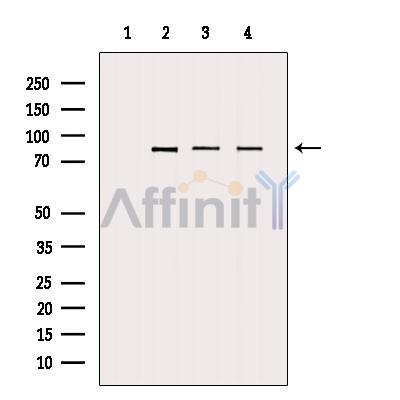DVL3 Antibody - #DF4455
製品説明
*The optimal dilutions should be determined by the end user. For optimal experimental results, antibody reuse is not recommended.
*Tips:
WB: For western blot detection of denatured protein samples. IHC: For immunohistochemical detection of paraffin sections (IHC-p) or frozen sections (IHC-f) of tissue samples. IF/ICC: For immunofluorescence detection of cell samples. ELISA(peptide): For ELISA detection of antigenic peptide.
引用形式: Affinity Biosciences Cat# DF4455, RRID:AB_2836810.
折りたたみ/展開
Dishevelled 3 (homologous to Drosophila dsh); Dishevelled 3; Dishevelled 3, dsh homolog (Drosophila); Dishevelled, dsh homolog 3 (Drosophila); Dishevelled-3; DSH homolog 3; dvl3; DVL3_HUMAN; KIAA0208; OTTHUMP00000210777; OTTHUMP00000210778; Segment polarity protein dishevelled homolog DVL 3; Segment polarity protein dishevelled homolog DVL-3;
免疫原
A synthesized peptide derived from human DVL3, corresponding to a region within the internal amino acids.
- Q92997 DVL3_HUMAN:
- Protein BLAST With
- NCBI/
- ExPASy/
- Uniprot
MGETKIIYHLDGQETPYLVKLPLPAERVTLADFKGVLQRPSYKFFFKSMDDDFGVVKEEISDDNAKLPCFNGRVVSWLVSAEGSHPDPAPFCADNPSELPPPMERTGGIGDSRPPSFHPHAGGGSQENLDNDTETDSLVSAQRERPRRRDGPEHATRLNGTAKGERRREPGGYDSSSTLMSSELETTSFFDSDEDDSTSRFSSSTEQSSASRLMRRHKRRRRKQKVSRIERSSSFSSITDSTMSLNIITVTLNMEKYNFLGISIVGQSNERGDGGIYIGSIMKGGAVAADGRIEPGDMLLQVNEINFENMSNDDAVRVLREIVHKPGPITLTVAKCWDPSPRGCFTLPRSEPIRPIDPAAWVSHTAAMTGTFPAYGMSPSLSTITSTSSSITSSIPDTERLDDFHLSIHSDMAAIVKAMASPESGLEVRDRMWLKITIPNAFIGSDVVDWLYHNVEGFTDRREARKYASNLLKAGFIRHTVNKITFSEQCYYIFGDLCGNMANLSLHDHDGSSGASDQDTLAPLPHPGAAPWPMAFPYQYPPPPHPYNPHPGFPELGYSYGGGSASSQHSEGSRSSGSNRSGSDRRKEKDPKAGDSKSGGSGSESDHTTRSSLRGPRERAPSERSGPAASEHSHRSHHSLASSLRSHHTHPSYGPPGVPPLYGPPMLMMPPPPAAMGPPGAPPGRDLASVPPELTASRQSFRMAMGNPSEFFVDVM
種類予測
Score>80(red) has high confidence and is suggested to be used for WB detection. *The prediction model is mainly based on the alignment of immunogen sequences, the results are for reference only, not as the basis of quality assurance.
High(score>80) Medium(80>score>50) Low(score<50) No confidence
研究背景
Involved in the signal transduction pathway mediated by multiple Wnt genes.
Ubiquitinated. Deubiquitinated by CYLD, which acts on 'Lys-63'-linked ubiquitin chains.
Phosphorylated by CSNK1D.
Arginine methylation may function as a switch in regulation of function in Wnt signaling.
Cytoplasm.
Belongs to the DSH family.
研究領域
· Cellular Processes > Cellular community - eukaryotes > Signaling pathways regulating pluripotency of stem cells. (View pathway)
· Environmental Information Processing > Signal transduction > mTOR signaling pathway. (View pathway)
· Environmental Information Processing > Signal transduction > Wnt signaling pathway. (View pathway)
· Environmental Information Processing > Signal transduction > Notch signaling pathway. (View pathway)
· Environmental Information Processing > Signal transduction > Hippo signaling pathway. (View pathway)
· Human Diseases > Infectious diseases: Viral > Human papillomavirus infection.
· Human Diseases > Infectious diseases: Viral > HTLV-I infection.
· Human Diseases > Cancers: Overview > Pathways in cancer. (View pathway)
· Human Diseases > Cancers: Specific types > Basal cell carcinoma. (View pathway)
· Human Diseases > Cancers: Specific types > Breast cancer. (View pathway)
· Human Diseases > Cancers: Specific types > Hepatocellular carcinoma. (View pathway)
· Human Diseases > Cancers: Specific types > Gastric cancer. (View pathway)
· Organismal Systems > Endocrine system > Melanogenesis.
Restrictive clause
Affinity Biosciences tests all products strictly. Citations are provided as a resource for additional applications that have not been validated by Affinity Biosciences. Please choose the appropriate format for each application and consult Materials and Methods sections for additional details about the use of any product in these publications.
For Research Use Only.
Not for use in diagnostic or therapeutic procedures. Not for resale. Not for distribution without written consent. Affinity Biosciences will not be held responsible for patent infringement or other violations that may occur with the use of our products. Affinity Biosciences, Affinity Biosciences Logo and all other trademarks are the property of Affinity Biosciences LTD.


